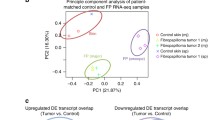Abstract
Damselfish neurofibromatosis (DNF) is a cancer affecting bicolor damselfish (Pomacentrus partitus) on reefs in South Florida, USA. Bicolor damselfish exhibiting DNF were observed on 18 of 19 reefs surveyed, with prevalence rates varying from 0.4 to 23.8% of the adult fish in these populations. These rates were very stable over 5 to 9 yr periods (1981 to 1989) on the two reefs monitored. High disease prevalence was associated with a high population density of large size-class fish and a population structure dominated by large fish. These patterns were observed both between and within reef populations. The distribution of cases within reefs was clustered rather than uniform or random. These findings are consistent with the hypothesis that DNF is distributed primarily via fish to fish (horizontal) transmission of an infectious agent. Disease patterns are not consistent with what would be expected to result from inherited (or vertically transmitted) or water-borne agents.
Similar content being viewed by others
Literature cited
Bell, L. J., Moyer, J. T., Numachi, K. (1982). Morphological and genetic variation in Japanese populations of the anemonefishAmphiprion clarkii. Mar. Biol. 72: 99–108
Brodey, R. S., McDonough, S. K., Frye, F. L., Hardy, W. D. (1970). Epidemiology of feline leukemia (lymphosarcoma). In: Dutcher, R. M. (ed.) Comparative leukemia research 1969. Chapter IV. Feline, canine and porcine leukosis. Karger, Basel, p. 333–342
Clarke, M. E., Eakin, M. C., Dowd, C., Schmale, M. C. (1988). Age of recruitment of bicolor damselfish (Pomacentrus partitus) to reefs in southern Florida. Rapp. P.-v. Réun. Cons. perm. int. Explor. Mer 191: p. 457
Diggle, P. J. (1983). Statistical analysis of spatial point patterns. Academic Press, New York
Farley, C. A., Otto, S. V., Reinisch, C. L. (1986). New occurrence of epizootic sarcoma in Chesapeake Bay soft shell clams,Mya arenaria. Fish Bull. U.S. 84: 851–857
Ghoneum, M., Faisal, M., Peters, G., Ahmed, I. I., Cooper, E. L. (1988). Suppression of natural cytotoxic cell activity by social aggressiveness inTilapia. Devl comp. Immun., N.Y. 12: 595–602
Green, R. H. (1979). Sampling design and statistical method for environmental biologists. Wiley-Interscience, New York
Kent, M. L., Elston, R. A., Wilkinson, M. T., Drum, A. S. (1989). Impaired defense mechanisms in bay mussels,Mytilus edulis, with hemic neoplasia. J. Invertebr. Path. 53: 378–386
Lacson, J. M., Riccardi, V. M., Calhoun, S. W., Morizot, D. C. (1989). Genetic differentiation of bicolor damselfish (Eupomacentrus partitus) populations in the Florida Keys. Mar. Biol. 103: 445–451
Lee, T. N. (1986). Coastal circulation in the Key Largo coral reef marine sanctuary. In: van de Kreeke, J. (ed.) Physics of shallow estuaries and bays. Springer-Verlag, Berlin, p. 178–198
Lessios, H. A. (1988). Mass mortality ofDiadema antillarum in the Caribbean: what have we learned? A. Rev. Ecol. Syst. 19: 371–393
Malins, D. C., McCain, B. B., Brown, D. W., Chan, S., Myers, M. S., Landahl, J. T., Prohaska, P. G., Friedman, A. J., Rhodes, L. D., Burrows, D. G., Gronlund, W. D., Hodgins, H. O. (1984). Chemical pollutants in sediments and diseases of bottomdwelling fish in Puget Sound, Washington. Envir. Sci. Technol. 18: 705–713
Marszalek, D. S., Babashoff, G. J, Noel, M. R., Worley, D. R. (1977). Reef distribution in South Florida. Proc. 3rd int. coral Reef Symp. 2: 223–230. [Taylor, D. L. (ed.) Rosenstiel School of Marine and Atmospheric Science, University of Miami]
Mix, M. C. (1986). Cancerous diseases in aquatic animals and their association with environmental pollutants: a critical literature review. Mar. envirl Res. 20: 1–111
Myrberg, A. A. (1972). Social dominance and territoriality in the bicolor damselfish,Eupomacentrus partitus. Behaviour 41: 207–231
Pielou, E. C. (1977). Mathematical ecology. Wiley, New York
Robertson, D. R., Green, D. G., Victor, B. C. (1988). Temporal coupling of production and recruitment of larvae of a Caribbean reef fish. Ecology 69: 370–381
Schmale, M. C. (1979). Sexual selection and reproductive success in males of the bicolor damselfish,Eupomacentrus partitus (Pisces: Pomacentridae). Masters thesis. University of Miami, Miami, Florida
Schmale, M. C. (1981). Sexual selection and relative reproductive success in males of the bicolor damselfish,Eupomacentrus partitus. Anim. Behav. 29: 1172–1184
Schmale, M. C., Hensley, G. T. (1988). Transmissibility of a neurofibromatosis-like disease in bicolor damselfish. Cancer Res. 48: 3828–3833
Schmale, M. C., Hensley, G. T., Udey, L. R. (1983). Multiple schwannomas in the bicolor damselfish,Pomacentrus partitus; a possible model of von Recklinghausen neurofibromatosis. Am. J. Path. 112: 238–241
Schmale, M. C., Hensley, G. T., Udey, L. R. (1986). Neurofibromatosis in the bicolor damselfish, (Pomacentrus partitus) as a model of von Recklinghausen neurofibromatosis. Ann. N.Y. Acad. Sci. 486: 386–402
Schmale, M. C., McKinney, E. C. (1987). Immune responses in the bicolor damselfish,Pomacentrus partitus, and their potential role in the development of neurogenic tumors. J. Fish Biol. 31A: 161–166
Scott, D. B. C., Currie, C. E. (1980). Social hierarchy in relation to adrenocortical activity inXiphophorus helleri Heckel. J. Fish Biol. 16: 265–277
Shaklee, J. B. (1984). Genetic variation and population structure in the damselfish,Stegastes fasciolatus, throughout the Hawaiian Archipelago. Copeia 3: 629–640
Sonstegard, R. (1976). Studies of the etiology and epizootiology of lymphosarcoma inEsox (Esox lucius L. andEsox masquinongy). Prog. exp. Tumor Res. 20: 141–155
Victor, B. C. (1984). Coral reef fish larvae: patch size estimation and mixing in the plankton. Limnol. Oceanogr. 29: 1116–1119
Wolf, K. (1988). Fish viruses and fish viral diseases. Cornell University Press, Ithaca, New York
Author information
Authors and Affiliations
Additional information
Communicated by J. M. Lawrence, Tampa
Rights and permissions
About this article
Cite this article
Schmale, M.C. Prevalence and distribution patterns of tumors in bicolor damselfish (Pomacentrus partitus) on South Florida reefs. Mar. Biol. 109, 203–212 (1991). https://doi.org/10.1007/BF01319388
Accepted:
Issue Date:
DOI: https://doi.org/10.1007/BF01319388




